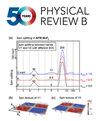非平衡多轨道系统的混合构型近似
IF 3.7
2区 物理与天体物理
Q1 Physics and Astronomy
引用次数: 0
摘要
我们提出了一种基于单波段杂质解算器的混合构型近似,以适度的计算成本有效地研究非平衡多轨道系统。在这项工作中,我们将该方法与所谓的辅助主方程方法合并。作为一个基准,我们首先证明了我们的方法在平衡状态下以良好的总体精度再现了量子蒙特卡罗(QMC)的结果,特别是对于非简并轨道。然后,我们使用我们的方法作为动态平均场理论(DMFT)的杂质求解器来解决双轨、现实分层结构的情况,恢复了通过用QMC求解DMFT自一致循环所观察到的强晶体场驱动的电荷极化,尽管略有减少。最后,我们通过将该层夹在受不同化学势描述的偏置电压的金属触点之间来解决原型非平衡设置。这个简化模型证明了我们的方法有潜力获得多轨道、现实材料的非平衡稳态行为。这些发现为直接在实频域研究多轨道化合物的非平衡性质提供了第一步理论基础。本文章由计算机程序翻译,如有差异,请以英文原文为准。
Mixed-configuration approximation for multiorbital systems out of equilibrium
We propose a mixed-configuration approximation based on single-band impurity solvers to efficiently study nonequilibrium multiorbital systems at moderate computational cost. In this work, we merge the approach with the so-called auxiliary master equation approach. As a benchmark, we first show that our approach reproduces the results of quantum Monte Carlo (QMC) for two-orbital impurity models at equilibrium with overall good accuracy, especially for nondegenerate orbitals. We then use our approach as an impurity solver for dynamical mean-field theory (DMFT) to address the case of a two-orbital, realistic layered structure, recovering the strong crystal-field-driven charge polarization observed by solving the DMFT self-consistent cycle with QMC, albeit slightly reduced. Finally, we address a prototype nonequilibrium setup by sandwiching this layer between metallic contacts subject to a bias voltage described by different chemical potentials. This simplified model demonstrates our method's potential to access nonequilibrium steady-state behavior of multiorbital, realistic materials. These findings provide a first-step basis for theoretical studies of nonequilibrium properties of multiorbital compounds directly in the real frequency domain.
求助全文
通过发布文献求助,成功后即可免费获取论文全文。
去求助
来源期刊

Physical Review B
物理-物理:凝聚态物理
CiteScore
6.70
自引率
32.40%
发文量
0
审稿时长
3.0 months
期刊介绍:
Physical Review B (PRB) is the world’s largest dedicated physics journal, publishing approximately 100 new, high-quality papers each week. The most highly cited journal in condensed matter physics, PRB provides outstanding depth and breadth of coverage, combined with unrivaled context and background for ongoing research by scientists worldwide.
PRB covers the full range of condensed matter, materials physics, and related subfields, including:
-Structure and phase transitions
-Ferroelectrics and multiferroics
-Disordered systems and alloys
-Magnetism
-Superconductivity
-Electronic structure, photonics, and metamaterials
-Semiconductors and mesoscopic systems
-Surfaces, nanoscience, and two-dimensional materials
-Topological states of matter
 求助内容:
求助内容: 应助结果提醒方式:
应助结果提醒方式:


